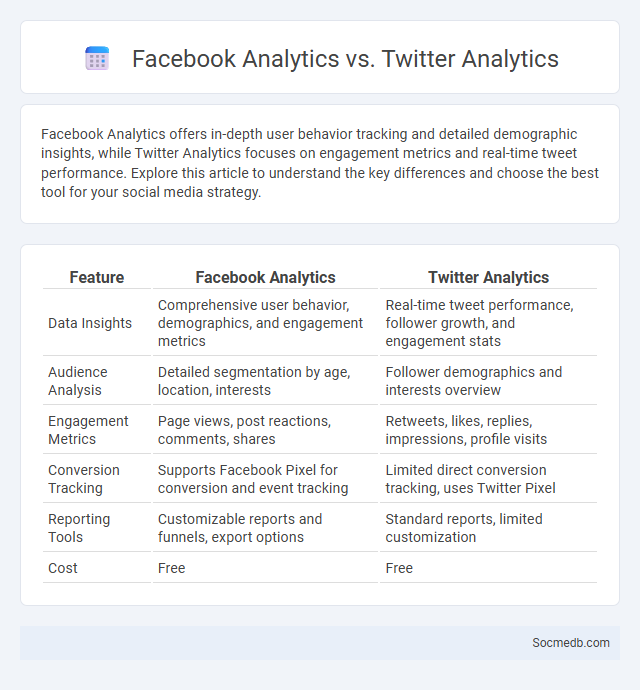
Photo illustration: Facebook Analytics vs Twitter Analytics
Facebook Analytics offers in-depth user behavior tracking and detailed demographic insights, while Twitter Analytics focuses on engagement metrics and real-time tweet performance. Explore this article to understand the key differences and choose the best tool for your social media strategy.
Table of Comparison
| Feature | Facebook Analytics | Twitter Analytics |
|---|---|---|
| Data Insights | Comprehensive user behavior, demographics, and engagement metrics | Real-time tweet performance, follower growth, and engagement stats |
| Audience Analysis | Detailed segmentation by age, location, interests | Follower demographics and interests overview |
| Engagement Metrics | Page views, post reactions, comments, shares | Retweets, likes, replies, impressions, profile visits |
| Conversion Tracking | Supports Facebook Pixel for conversion and event tracking | Limited direct conversion tracking, uses Twitter Pixel |
| Reporting Tools | Customizable reports and funnels, export options | Standard reports, limited customization |
| Cost | Free | Free |
Introduction to Social Media Analytics
Social media analytics involves collecting and analyzing data from social platforms to understand user behavior, engagement patterns, and content performance. By leveraging tools that track metrics such as likes, shares, comments, and reach, you can uncover actionable insights that enhance your marketing strategies. This data-driven approach helps optimize content targeting, improve brand visibility, and increase audience interaction effectively.
Overview of Facebook Analytics
Facebook Analytics provides comprehensive insights into user behavior, engagement metrics, and audience demographics across Facebook pages and apps. It enables marketers to track conversion paths, measure campaign performance, and optimize content strategies through detailed reports and data visualization tools. With integration capabilities spanning Facebook Ads, Instagram, and Messenger, it offers a unified platform for advanced social media analytics and business intelligence.
Overview of Twitter Analytics
Twitter Analytics provides detailed insights into tweet performance, audience demographics, and engagement metrics. Users can track impressions, retweets, likes, profile visits, and follower growth to optimize social media strategies. Data from Twitter Analytics helps businesses and influencers understand content reach and user interactions to enhance brand visibility.
General Analytics: Definition and Scope
General analytics in social media involves the systematic collection and analysis of data from various platforms to understand user behavior, engagement patterns, and content performance. It encompasses metrics such as reach, impressions, sentiment analysis, and demographic insights to optimize marketing strategies and enhance audience targeting. By leveraging tools like social listening and real-time dashboards, businesses can make data-driven decisions that improve brand visibility and customer interaction.
Key Metrics Compared: Facebook vs Twitter vs General Analytics
Facebook's key metrics include engagement rate, reach, and click-through rate, providing detailed demographic insights ideal for targeted marketing. Twitter emphasizes real-time metrics like tweet impressions, retweets, and hashtag performance, useful for trend tracking and brand interaction. Your choice between platforms should consider these analytics to optimize content strategy and maximize audience impact.
Data Collection Methods and Tools
Social media platforms utilize advanced data collection methods such as user behavior tracking, cookies, and third-party integrations to gather detailed insights. Tools like social media analytics software, sentiment analysis engines, and customer relationship management (CRM) systems help analyze engagement metrics and user preferences. Understanding these data collection practices empowers you to optimize your social media strategy effectively.
User Demographics and Audience Insights
Understanding user demographics on social media platforms allows you to tailor content that resonates with your target audience's age, gender, location, and interests. Audience insights provide valuable data on user behavior, engagement patterns, and preferences, enabling more precise marketing strategies. Leveraging these analytics helps maximize your reach and foster deeper connections with your social media followers.
Engagement Tracking: Likes, Shares, Retweets, and More
Engagement tracking on social media platforms involves monitoring key metrics such as likes, shares, retweets, comments, and saves to measure content performance and audience interaction. Advanced analytics tools provide insights into user behavior patterns, helping brands optimize their strategies for increased reach and conversion rates. Tracking engagement metrics in real time allows for agile adjustments in campaign management, enhancing overall social media ROI.
Reporting Features and Visualization
Social media platforms offer robust reporting features that provide detailed insights into audience engagement, reach, and content performance. These tools visualize data through graphs, charts, and heatmaps, enabling you to quickly interpret trends and optimize strategies. Leveraging advanced analytics dashboards enhances your ability to make data-driven decisions for improving social media campaigns.
Choosing the Right Analytics Platform for Your Goals
Selecting the ideal social media analytics platform hinges on aligning its features with your specific marketing goals, such as tracking engagement, follower growth, or conversion rates. Platforms like Sprout Social, Hootsuite Analytics, and Buffer Analyze offer tailored insights into audience behavior and content performance, enabling data-driven decision-making. Evaluating factors such as real-time reporting, integration capabilities, and user-friendly dashboards ensures the analytics tool supports your campaign objectives and ROI measurement effectively.
 socmedb.com
socmedb.com